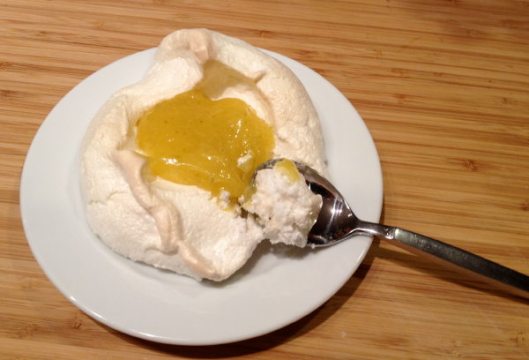Having received an unexpected (and wonderful) gift of a box of Texas citrus, I began a flurry of cooking using the grapefruits, lemons, limes, and tangerines. The most amazing and wonderful thing ever, though, was made with the limes: a lime curd Pavlova.
 If you aren’t familiar with Pavlova, it’s a meringue-like ‘crust’ on which is layered fruit, cream, or other good things. It originates from the Southern Hemisphere, and it’s time to bring it home. This is good stuff indeed!
If you aren’t familiar with Pavlova, it’s a meringue-like ‘crust’ on which is layered fruit, cream, or other good things. It originates from the Southern Hemisphere, and it’s time to bring it home. This is good stuff indeed!
Once you have made lime curd and pavlovas, it’s a simple matter to plop the curd into the pretty cloud and grab a spoon. This tastes sublime. It’s sweet/tart, crunchy/soft, ethereal/substantial … and best of all, can be assembled and served at a moment’s notice, as long as you have the curd in your refrigerator, and the meringues already made.
Pavlovas are much easier to make than I had thought. So for a show-stopping dessert that can be made ahead of time, seek no further.
I am indebted to Marisa McClellan for her recipe for Zesty Lime Curd shown below, published in her splendid book Food in Jars. With her kind permission, I’ll include her basic (albeit somewhat abbreviated) recipe here, but for full instructions, including concise directions on canning it into jars, so that it’s shelf-stable, you’ll have to read the book. This is a fabulous book. Get a copy for yourself and give it as a gift. (Note: I have received no compensation; this is my own genuine opinion.)
Marisa’s Zesty Lime Curd
- 1/4 c finely grated lime zest (from about 4 limes)
- 1 1/4 c granulated sugar
- 4 large egg yolks
- 2 large eggs
- 1/2 c freshly squeezed lime juice (from about 6 limes)
- 6 Tbsp cold unsalted butter, cut into cubes
Combine the lime zest and sugar in a small bowl. Rub the zest into the sugar until it is fragrant and fully combined. Set aside.
Set up a double boiler, add 2 inches of water to the bottom pan and bring to a simmer over medium heat. Keeping the top half of the double boiler off the stove, add the egg yolks and whole eggs to it and whisk them together. Add the zest and sugar combination and whisk in. Finally, add the lime juice and stir until blended.
Put the double boiler back together, and drop in the cubes of butter. Switch to a silicone spatula and stir continually as the lime curd cooks.
Monitor the temperature of the curd while you stir. As it approaches 190˚F it should start to thicken. One sign of doneness is that it will coat the back of your spatula without running or dripping.
When the curd has thickened to the consistency of sour cream, it is done. Remove the top half of the double boiler and stir off the heat. During this time, it will continue to thicken a bit.
Strain the curd through a fine-mesh sieve into a 4-cup measure.
Individual Pavlovas
- 4 large egg whites, at room temperature
- 1 c granulated sugar (or, even better, superfine sugar)
- 1 tsp white vinegar
- 1 1/2 tsp cornstarch
- 1/2 tsp vanilla extract
Preheat oven to 275˚F, and place the rack in the middle of the oven. Line a baking sheet with parchment paper.
In a clean mixing bowl, beat the egg whites on medium speed of an electric mixer. Beat continuously until the eggs form soft peaks. While beating, sprinkle in the sugar, one teaspoon at a time. It’s important that you don’t just dump the sugar in, it must go in gradually. Keep beating until all the sugar is incorporated, and the egg whites form glossy stiff peaks.
Stop the mixer, then sprinkle the whites with cornstarch and vinegar. Fold this in gently with a spatula. Add the vanilla, and fold again.
Use a spoon to spread the meringue into 4 inch rounds on the parchment – my batch made 6 rounds, but you should get at least 4. Leave 2 inches of space between each one. Use the back of the spoon to make a small well in the middle of each meringue.
Bake in the 275˚ oven 30 minutes, until they show a light tan/pink eggshell color. Now turn the oven off, and leave the door slightly ajar, to let the meringues cool completely. They might deflate if introduced to cool air too soon! As the meringues cool, they might crack slightly, this is okay.
Use immediately, or store, nested in waxed paper, in a cool place, stored in an airtight tin.
